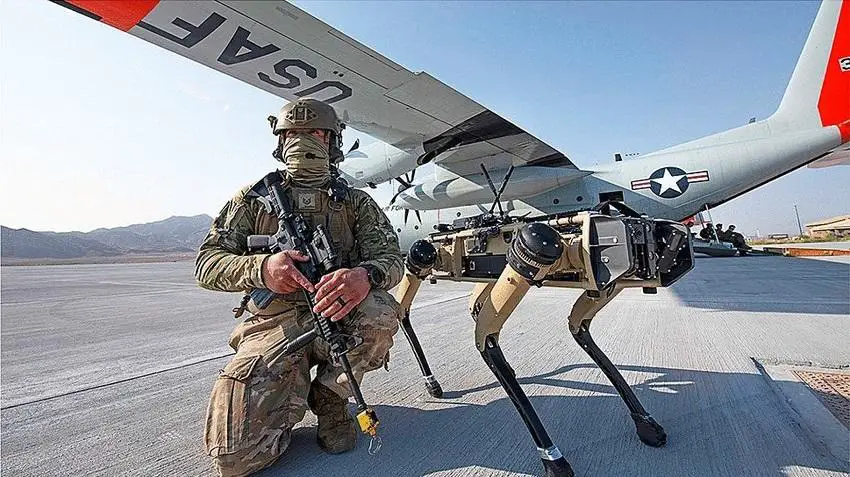In December 2021, the Portland Air National Guard Base (PANGB) became the first Air National Guard base to house the innovative technology developed by Ghost Robotics known as the Quadrupedal Unmanned Ground Vehicle (QUGV). This four-legged droid is most commonly referred to as a robot dog. The new addition to the PANGB family has been under the care of the 142nd Security Forces Squadron here. The canine-like body of the QUGV reflects the beams of sunshine off of its exterior, and with one click of a button, it is awakened. 142nd Security Forces Squadron logistics and resources noncommissioned officer, Tech. Sgt. Jamie Cuniff, has been working with the new technology since its arrival at PANGB.
“It’s going to give us exponentially more, real time ground situational awareness. I see the dog bringing a lot of additional capability down the road. Say we have a building alarm or an event we need to respond to on the installation– the dog can go with us or first and provide us a video feed of what’s going on inside the building, while also providing a two way interface that allows us the ability to start affecting the situation while other Defenders respond. Maybe not a robot dog, but to find things that humans don’t necessarily have to do, or don’t do well and incorporate technology or some version of innovation to free up the manpower while also enhancing capability,” said 142nd Security Forces Commander, Lt. Col. Ryan Barton.
“We’re kind of spearheading this whole side of security, this autonomous defender as they say, which makes me feel really good and proud to be in the unit. From a security standpoint, it’s going to benefit us in the way that it provides some real time video feedback and also acts as a deterrent,” said Cuniff. Cuniff has been a key advocate for the adoption of the robot dog, and has been the leading force in getting it ready for its security mission here.

This semi-autonomous robot is programmed to minimize human exposure to danger. The unique capabilities of the robot, including its sensor package, creates a notable advantage for base security. The robot can independently track the perimeter of the base, endure a variety of terrain, scan the area with multiple different camera types, travel long distances on one charge, provide active surveillance of the area, and funnel that information back to those in the Security Forces Squadron through secure means. The Defenders can interrupt the autonomous function of the dog at any time, and manually control it, as a means to focus or direct the capability based on the circumstance.
The use of the robot prevents real dogs and humans from being unnecessarily exposed to danger. Additionally, the camera capabilities provide information that would not be perceptible to the human eye. According to Barton, looking forward, the base is working to gain two more QUGVs, for a total of three dogs which will provide enhanced security to the base, protecting our personnel as well as our mission assets. This novel addition to the 142nd Wing brings with it the ability to enhance PANG’s mission effectiveness through additional detection and alert capability, freeing up time for the defender to become more proficient in their skill sets, as we move into the future.
Avik De and Gavin Kenneally are quintessential entrepreneurs. While completing their PhDs at Penn under Daniel Koditschek, famed legged roboticist at the GRASP Lab, they began their journey to build a better-legged robot after experiencing the state-of-the-art at that time, which was not scalable for commercialization and relied on expensive, fragile, and non-standard components. More importantly, they recognized the need to build mobile robots for customers, not just viral videos and lab experiments. Before formally launching the company in 2015 with Jiren Parikh, they spent years developing the foundational architecture and electronics, including a high bandwidth actuator and ultra-fast small-footprint reactive controller system that mimics how mammals move over unstructured terrain, while compensating for the fundamental drawbacks of mechanical systems trying to emulate biological designs.

















